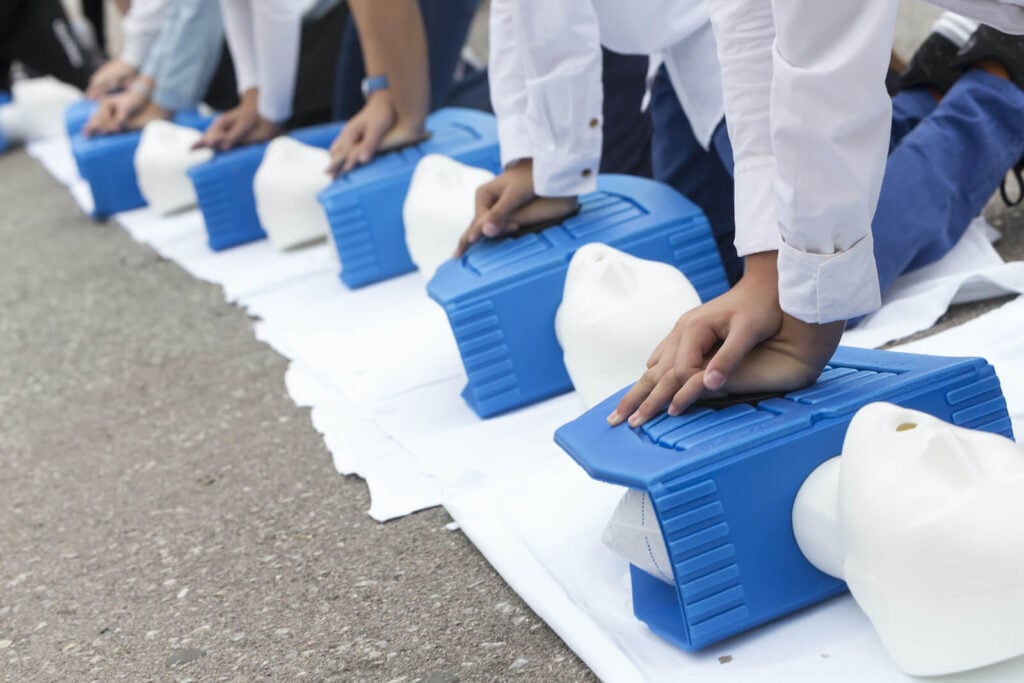
Last Updated On: septiembre 23, 2024
Cardiopulmonary resuscitation (CPR) is a lifesaving technique that helps circulate blood during a cardiac arrest event. While ACLS and PALS certification courses teach CPR, they are intended for a different group of people than standard CPR training.
Standard CPR certifications are intended for bystanders looking to help their community by receiving training in responding to cardiac arrest emergencies. ACLS and PALS are intended for medical professionals. ACLS teaches these professionals how to respond to a wider array of emergencies while PALS specifically focuses on responding to infant and child cardiopulmonary responses.
American CPR Care Association is here for all of your cardiopulmonary resuscitation training and certification needs. We offer comprehensive, affordable, and flexible blended online CPR certifications. Continue reading to learn about the differences between CPR, ACLS, and PALS and whether they apply to your specific situation.
CPR, or cardiopulmonary resuscitation, is an emergency lifesaving procedure performed when the heart stops beating. Performing CPR immediately following a cardiac arrest event can double or triple the chances of survival for patients.
CPR involves performing chest compressions and rescue breaths. Though experts recommend bystanders should perform compression-only CPR if they are not certified. Most online CPR classes include AED training in addition to CPR training. Using an automatic external defibrillator (AED) issues shocks to a heart in ventricular fibrillation. When the heart goes into cardiac arrest, a shock from a defibrillator can restore a normal heart rhythm.
CPR certifications are for anyone who wants to be able to provide a service to their community and potentially save lives. However, there are specific industries that require CPR certification such as doctors, nurses, healthcare workers, police, sheriffs, firefighters, rescue personnel, and other emergency responders. The laws for obtaining your CPR certification for certain professions vary from state to state.
For example, in Virginia, a law passed by the General Assembly requires all teachers to obtain a CPR certification. These professionals typically require more advanced training in addition to CPR certifications.
ACLS is designed for healthcare professionals directly participating in the management of cardiopulmonary arrest or other cardiovascular emergencies and for personnel in emergency response. This class teaches the following skills:
ACLS is for anyone who has to proficiently read and interpret ECGs, understand ACLS pharmacology, and regularly leads or participates in emergency assessment and treatment of pre-arrest, arrest, and post-arrest patients.
PALS certifications are different from CPR, BLS, and ACLS certifications. The difference is a focus specifically on responding to critically injured or ill infants or children. By the end of the course, professionals should learn PALS treatment algorithms, team dynamics, effective resuscitation, and effective pediatric assessment.
The topics covered in a PALS certification courses include:
With PALS, the ultimate goal is to ensure the most favorable outcome for all cardiopulmonary emergencies with infants and children.
The PALS certification is intended primarily for nurses and paramedics or those currently working with emergency response, emergency medicine, intensive care, and critical care units. Any field or position that takes the responsibility of caring for a child’s life should receive their PALS certification.
This course teaches teams how to respond to these emergencies in a coordinated effort. It uses simulated pediatric emergencies to reinforce important concepts of a systematic approach to pediatric assessment, basic life support, PALS treatment algorithms, effective resuscitation, and team dynamics.
CPR, ACLS, and PALS have specific applications, and you should be aware of them to understand which classifications you need the most.
CPR is intended for everyday bystanders trying to be of more service to their community. The more people who receive their CPR certification, the more likelihood there is that a bystander will be able to save someone’s life if they suffer an out-of-hospital sudden cardiac arrest.
ACLS and PALS are more specialized and are intended for medical professionals who have to regularly respond to cardiopulmonary emergencies. ACLS covers a broader spectrum of cardiac emergencies while PALS focuses exclusively on infant and children cardiopulmonary care.
Whether you’re a bystander looking to sharpen your CPR skills or you’re a professional worker, American CPR Care Association is here for all of your CPR skill needs. Our online certifications offer flexibility and expertise that makes sharpening your cardiac arrest response skills simple and attainable.
Contact us today to learn more about what American CPR Care Association can do for you.